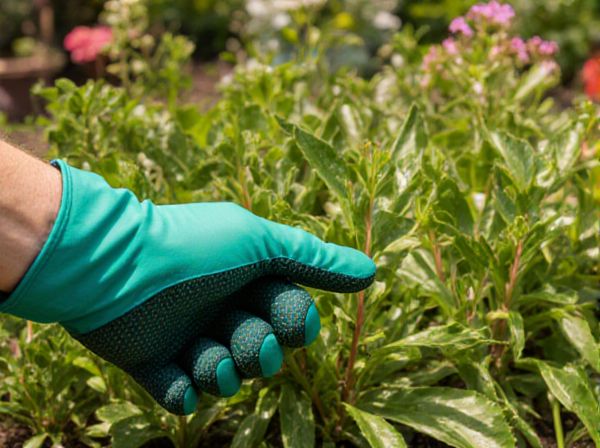
Heat-tolerant plants vs cold-hardy plants Illustration
Heat-tolerant plants thrive in high temperatures by storing water efficiently and reducing leaf surface area to minimize moisture loss, making them ideal for arid and hot climates. Cold-hardy plants possess antifreeze proteins and robust cellular structures that prevent ice formation, enabling survival in freezing temperatures often seen in temperate and polar regions. Selecting the right plant type based on climate resilience enhances garden sustainability and reduces the need for intensive maintenance or artificial climate control.
Table of Comparison
| Feature | Heat-Tolerant Plants | Cold-Hardy Plants |
|---|---|---|
| Optimal Temperature | Above 85degF (29degC) | Below 32degF (0degC) |
| Examples | Succulents, Cacti, Bougainvillea | Evergreens, Pansies, Spruces |
| Water Requirement | Low to Moderate | Moderate to High |
| Soil Type | Well-Drained, Sandy | Moist, Loamy |
| Sun Exposure | Full Sun | Partial to Full Sun |
| Growth Rate | Moderate to Fast | Slow to Moderate |
| Climate Zone | USDA Zones 9-11 | USDA Zones 3-7 |
| Survival Strategy | Drought Resistance, Heat Shock Proteins | Frost Tolerance, Antifreeze Proteins |
Understanding Heat-Tolerant and Cold-Hardy Plants
Heat-tolerant plants thrive in high-temperature environments by efficiently managing water loss and sustaining photosynthesis under intense sunlight, examples include succulents and agave species. Cold-hardy plants possess physiological adaptations like antifreeze proteins and altered cellular structures to withstand freezing temperatures, with common examples such as conifers and hellebores. Understanding these adaptations helps gardeners select appropriate species for specific climate zones, optimizing plant survival and growth.
Key Differences Between Heat-Tolerant and Cold-Hardy Varieties
Heat-tolerant plants thrive in high temperatures and often have adaptations such as waxy leaves or deep roots to conserve moisture, whereas cold-hardy plants possess mechanisms like antifreeze proteins and dormancy to survive freezing conditions. Heat-tolerant species, such as succulents and desert grasses, are typically drought-resistant, while cold-hardy varieties, including conifers and certain perennials, endure frost and snow. Understanding these physiological and structural differences is essential for selecting appropriate plants for specific climate zones and ensuring agricultural productivity.
Climate Zones and Plant Selection
Heat-tolerant plants thrive in USDA hardiness zones 9 through 11, where temperatures often exceed 85degF and drought conditions are common, making them ideal for arid and tropical climates. Cold-hardy plants are suited for zones 3 through 7, enduring temperatures as low as -40degF, and are preferred in temperate and continental climates with harsh winters. Selecting the right plants based on climate zones ensures optimal growth, reduces water usage, and enhances garden sustainability.
Top Heat-Tolerant Plants for Hot Gardens
Top heat-tolerant plants for hot gardens include agave, bougainvillea, and oleander, renowned for their ability to thrive in intense sunlight and high temperatures. These species exhibit adaptations such as drought resistance and heat-shielding foliage, making them ideal for climates with prolonged heat waves. Incorporating heat-tolerant plants reduces water usage and enhances landscape resilience in arid and semi-arid environments.
Leading Cold-Hardy Plants for Frosty Regions
Leading cold-hardy plants for frosty regions include species such as Siberian pea shrub (Caragana arborescens), hardy kiwi (Actinidia arguta), and Russian olive (Elaeagnus angustifolia), which thrive in temperatures as low as -40degF (-40degC). These plants possess adaptations like antifreeze proteins and deep root systems, enhancing their resilience against prolonged freezing conditions. Their ability to survive harsh winters while maintaining growth makes them vital for agriculture and landscaping in climates with severe frost.
Soil and Water Needs for Extreme Climates
Heat-tolerant plants thrive in well-draining, sandy soils that prevent waterlogging and conserve moisture, optimizing their survival in arid, high-temperature environments. Cold-hardy plants require moist, loamy soils rich in organic matter to retain warmth and support root resilience during freezing conditions. Efficient water management, such as deep irrigation for heat-tolerant species or controlled drainage for cold-hardy plants, is critical to maintaining soil health and ensuring plant endurance in extreme climates.
Sunlight Requirements: Heat vs Cold Adaptations
Heat-tolerant plants typically thrive under intense sunlight, requiring full sun exposure to activate their heat-resistant physiological mechanisms, such as enhanced transpiration and reflective leaf surfaces. Cold-hardy plants, adapted to lower temperatures, often prefer partial shade or filtered sunlight to avoid excessive solar radiation that can cause desiccation or frost damage despite their cold resistance. Understanding the sunlight requirements aligned with each plant's thermal adaptations is essential for optimizing growth and survival in varied climatic conditions.
Maintenance Tips for Climate-Resilient Gardens
Heat-tolerant plants such as succulents and native drought-resistant species require minimal watering and benefit from mulching to retain soil moisture and reduce temperature stress. Cold-hardy plants like conifers and ornamental grasses thrive with proper winter mulching and pruning to prevent damage from frost and heavy snow. Implementing soil enrichment and appropriate seasonal adjustments in watering schedules enhances overall plant resilience and garden sustainability in varying climate conditions.
Common Challenges and Solutions in Extreme Temperatures
Heat-tolerant plants often face challenges such as drought stress, leaf scorch, and reduced photosynthesis, whereas cold-hardy plants must withstand frost damage, cellular freezing, and ice formation in tissues. Solutions include selecting species with adaptive traits like deep root systems for heat tolerance and antifreeze proteins for cold resistance, alongside implementing mulching, proper watering strategies, and windbreaks to moderate microclimates. Utilizing genetic breeding and biotechnological advances also enhances resilience in both plant types against extreme temperature fluctuations.
Choosing the Right Plants for Your Local Climate
Selecting heat-tolerant plants is essential for regions experiencing high temperatures and prolonged droughts, as these species possess adaptations like deep root systems and waxy leaves to conserve water. Cold-hardy plants, typically found in cooler climates, can withstand frost and freezing temperatures through mechanisms such as antifreeze proteins and dormant growth phases. Understanding local climate patterns and soil conditions is crucial for choosing plants that thrive naturally, ensuring sustainable growth and minimizing maintenance.
Heat-tolerant plants vs cold-hardy plants Infographic

 gardendif.com
gardendif.com